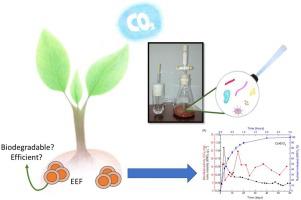Carbohydrate Polymers ( IF 10.7 ) Pub Date : 2021-01-16 , DOI: 10.1016/j.carbpol.2021.117635 Luciana Moretti Angelo , Débora França , Roselena Faez

|
Enhanced efficiency fertilizers (EEF) are an important subject for sustainable materials. It is fundamental for the released nutrient and biodegradation in the soil to have synergy to ensure material harmlessness. Chitosan, montmorillonite, and KNO3 were considered to develop the EEF because of the high biodegradation potential of the final product. We correlated the material biodegradability and release in water and soil to their formulation. We assume the materials are biodegradable since the biodegradation efficiency achieved over 30 %. As the nutrient diffusion and matrix degradation happen concomitantly, we also observed that the clay delays degradation and the KNO3 improved it. Likewise, the storage period can change the biodegradability properties once the material started to degrade. Hereupon, the amount of nutrient delivered will match the amount consumed by the plant, the matrix will degrade and no residue will be left in the soil.
中文翻译:

壳聚糖基微囊化肥料的生物降解性和生存力
高效肥料(EEF)是可持续材料的重要课题。土壤中释放的养分和生物降解具有协同作用以确保物质无害的基础。壳聚糖,蒙脱石和KNO 3被认为可以发展EEF,因为最终产品具有很高的生物降解潜力。我们将材料的生物降解性和在水和土壤中的释放与其配方相关联。我们假定材料是可生物降解的,因为其生物降解效率达到了30%以上。由于养分扩散和基质降解同时发生,我们还观察到粘土会延迟降解和KNO 3改善了它。同样,一旦材料开始降解,储存期就会改变生物降解性。因此,养分的输送量将与植物消耗的量相匹配,基质将降解,土壤中不会残留任何残留物。











































 京公网安备 11010802027423号
京公网安备 11010802027423号